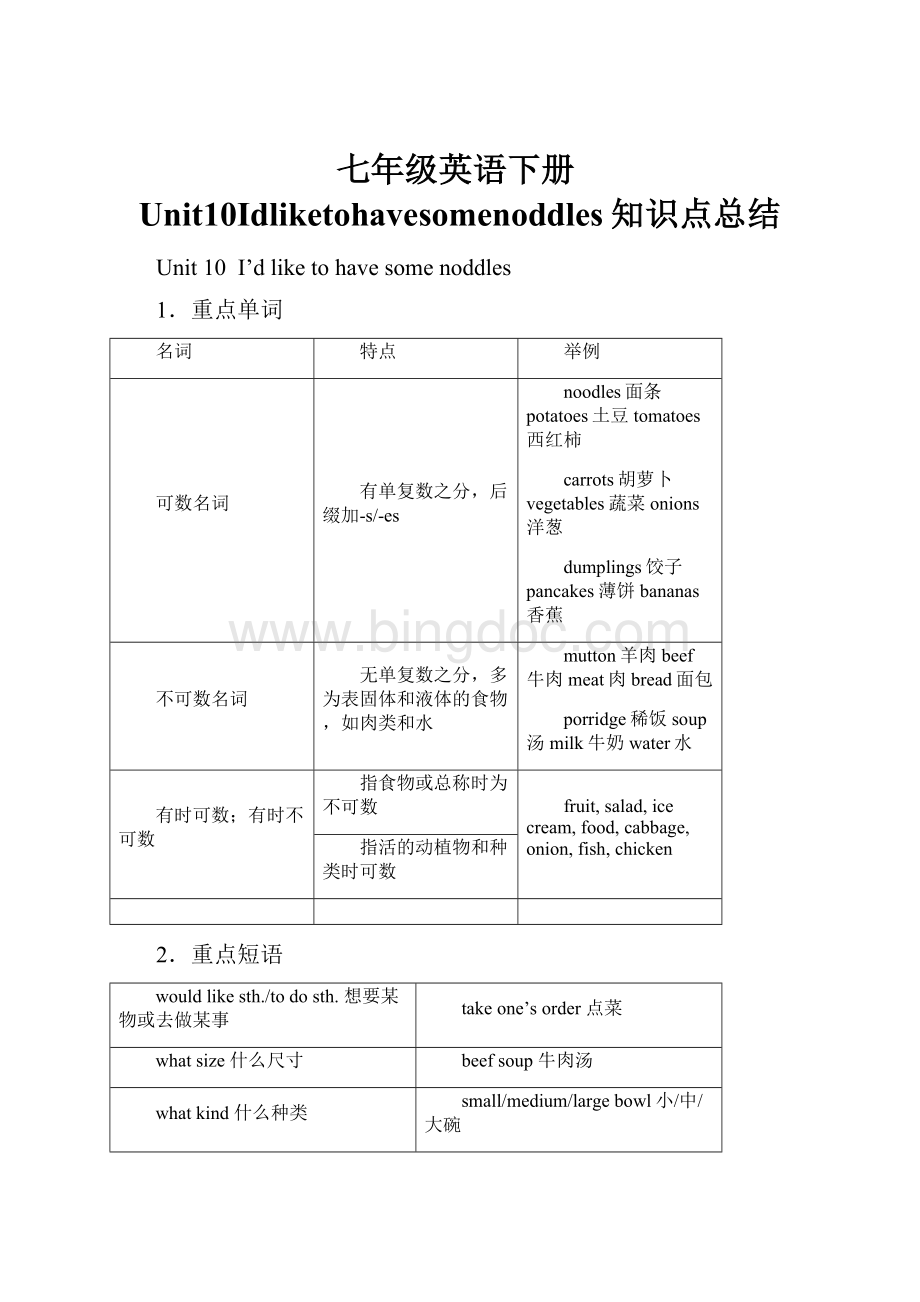七年级英语下册Unit10Idliketohavesomenoddles知识点总结Word格式.docx
《七年级英语下册Unit10Idliketohavesomenoddles知识点总结Word格式.docx》由会员分享,可在线阅读,更多相关《七年级英语下册Unit10Idliketohavesomenoddles知识点总结Word格式.docx(21页珍藏版)》请在冰点文库上搜索。

inonego一口气
3.知识点解析
1.I’dlikesomenoodles.
wouldlike表示“想要”,意义和用法和want相同,但是语气比want更委婉。
用法:
①wouldlikesth.想要某事
E.g.
I’dlikesomedumplings.
②wouldliketodosth.想要去做某事
They’dliketoplayfootballafterschool.
③wouldlikesb.todosth.想要某人去做某事
E.g.She’dlikemetogoshoppingwithher.
【注】I’d=IwouldYou’d=YouwouldShe’d=ShewouldThey’d=Theywould
句式一:
陈述句变一般疑问句,把情态动词would移到句首,I变为you。
E.g.Iwouldlikesomeorangejuice.→Wouldyoulikesomeorangejuice?
句式二:
陈述句变成否定句,在情态动词would后面加not,将some变any.
E.g.Shewouldlikesomewater.→Shewouldnotlikeanymilk?
句式三:
特殊疑问句(对划线部分提问)
E.g.Thesechildrenwouldlikesomemilk.→Whatwouldthesechildrenlike?
▲Wouldyoulikesth.?
你想要某物吗?
(委婉地询问对方的要求时的用语)
→肯定答语:
Yes,please.
→否定答语:
No,thanks.
E.g.--Wouldyoulikesometea?
--Yes,please./No,thanks.
▲Wouldyouliketodosth.?
你想要/愿意做某事吗?
(向对方有礼貌地提出建议或邀请)
→肯定回答:
Yes,I’dlike/loveto.是的,我愿意。
→否定回答:
Sorry,+原因。
E.g.--Wouldyouliketogoswimmingwithus?
--Yes,I’dloveto.
即学即练:
(1)I’dlikethem_____(stay)fordinnerwithus.
(2)Shelikes_____(watch)TVatnight.
(3)Whatkindoffruit______(will)youliketobuy?
(4)–Wouldyoulikeacupoftea?
-_______.
A.I’dlikemilk
B.Yes,Iwould
C.You’rewelcome
D.Yes,please
(5)Theywantsomegreentea.(同义句)They________________greentea.
(6)She’dlikesomerice.(改为一般疑问句)
______she__________rice?
2.Whatkindof…wouldyoulike?
你想要哪种....?
(常用来询问某人想要什么类型的…)E.g.—whatkindofnoddleswouldyoulike?
—I’dlikebeefnoodles,please.
▲kind作名词,表示“种类”。
常见短语Whatkindof....?
表示“哪种....?
”
E.g.Whatkindofmovieswouldyouliketosee?
【辨析】akindof表示“一种;
某种(类)…”
E.g.Whaleisakindofmamal(哺乳动物).
allkindsof“各种各样的…”
E.g.Thereareallkindsofanimalsinthezoo.
manydifferentkindsof“许多不同种类的…”
E.g.Ilikemanydifferentkindsofflower.
▲kind做形容词,意为“善良的、友好的”。
E.g.Hermotherisakindwoman.
常见短语:
bekindtosb.对某人友善;
友好=befriendly/goodtosb.
E.g.Youshouldbekind/friendly/goodtoyoursisters.
▲kindof+adj./adv表示“稍微;
有点”(相当于alittle)
E.g.Thislittleboyiskindof/alittleshy.
(1)Wewouldlike
tomatoandeggnoodles.(对划线部分提问)
_____________noodles______theylike?
(2)Lucylikesnoodles
withbeefandonions.
(对划线部分提问)
__________________noodles_____Lucylike?
3.Whatsize…wouldyoulike?
你想要多大....?
(常用来询问某人想要物体的尺寸大小)
E.g.①—Whatsizebowlofnoodleswouldhelike?
—He’dlikeasmall/medium/largebowlofnoodles.
E.g.②—Whatsizeshoesdoyouwear?
—Iwearsize40.
4.商品+be动词+钱数+for+商品数量
表示商品价格
E.g.TheseCDsareRMB10for3.TheapplesareRMB3for5.
—Howmuchisthiskindofdumplings?
—It’s10RMB_____20.
A.of
B.for
C.at
D.in
5.—Wouldyoulikealargebowl?
—Yes,please.
bowl表示“碗”常做量词→abowlof表示“一碗...”
E.g.I’dlikeabowlofrice.
【辨析】large,big,great
large“大的,大号的”,指物体面积、空间、范围上大。
反义词→small
E.g.wehaveahousewithalargeyard.
big“大的”,一般指物体的体积庞大、笨重,其反义词为small或little
E.g.UncleWanghasabighouse.
great意为“伟大的”,除表示数量、体积之大外,还指抽象的事物或精神方面
E.g.ChairMaoisagreatman.
6.Ifheorsheblowsoutallthecandlesinonego,thewishwillcometrue.
blowout表示“吹灭”
E.g.Thestrongwindblewoutthefire.
ina/onego表示“一口气”
E.g.Hetriestofinishhisworkina/onego.
▲wish既可以作动词也可以作名词
①作动词,表示“愿望;
希望”,常用wishtodosth.想要去做某事;
wishsb.sth.祝愿某人
E.g.IwishIcangotoBeijingnextsummer.
WewishyouamerryChristmas.
②作名词,表示“心愿;
愿望”,常用makeawish表示许愿。
E.g.Susanmadeawish.
cometrue表示“实现”,一般“梦想”作主语,后面不接宾语。
E.g.Wewanttoseeyoungpeople’sdreamscometrue.
7.--Whatwouldyoulike?
你想要什么?
--I’mnotsureyet.我还不确定。
sure作形容词,意为“确定的,有把握的”,常用结构:
①besureof/aboutsth.
②besuretodosth.
③besure+that从句
yet表示“还,仍然”,主要用于否定句和疑问句中,置于句末。
E.g.Theydoesn’tcomeyet.
8.Arethereanyvegetablesinthebeefnoodles?
【辨析】any和some
any
“一些”,用于否定句和疑问句中
Therearen’tanystudentsintheclassroom.
some
“一些”,用于肯定句中
Therearesomestudentsintheclassroom.
9.Idon’tlikeonions,greenteaorporridge.
or并列连词,用于否定句,表示“…和…都不”。
在句型转换时,把肯定句中的and改为or。
E.g.MrSmithsmokesanddrinks.
→MrSmithdoesn’tsmokeordrink.
10.Theynevercutupthenoodlesbecausethelongnoodlesareasymboloflonglife.
cutup表示“切碎”
E.g.Cutupthevegetables,please.
cutin表示“插话,插嘴”
E.g.Don’tcutinwhenothersaretalking.
cutdown表示“砍倒”
E.g.Theycutdownthetree.
11.We’dalsolikegongbaochickenandsomemapotofuwithrice.
①with为介词,意为“具有,带着”,其引导的介词短语withrice作后置定语,修饰mapotofu。
E.g.Thereisahousewithsixrooms.有一座六个房间的房子。
②with表示“带有...”作状语,表动作伴随。
E.g.MissLiwalksintotheclassroomwithasmileonherface.
③with表示“以....方式,用”
E.g.Youcaneatitwithaspoon.
12.Theanswerwouldbedifferentindifferentcountries.
▲answer既可以作名词,也可以作动词。
①作名词,意为“答案”
E.g.Thisisarightanswer.
②作动词,意为“回答”,常和question(问题)一起出现:
answerthequestion表示“回答问题”
E.g.Canyouanswertheteacher’squestion?
▲different形容词,意为“不同的”,反义词为same,意为“相同的”,常用于bedifferentfrom表示“与.......不同”
E.g.Oureatinghabitsaredifferentfromyours.
13.Howcanapersonmakehisorherbirthdaywishcometrue?
①makesb./sth.dosth.意为“使某人做某事”
E.g.Thisfunnystorymakesmelaughloudly.
②makesb.+形容词,表示“使某人(处于某种状态)”
E.g.Thenewsmakesushappy.
③makesb.+名词,表示“使某人成为....;
选某人为...”
E.g.WemakeTommonitor.
4.重点语法和句型
(一)餐厅用语
①我能帮您吗?
WhatcanIdoforyou?
=Can
I
help
you?
=
What
can
do
for
would
you
like?
②你们可以点菜了吗?
MayItakeyourordernow?
③我想要一些面条。
I’d
like
some
noodles.
(I’d
would)
(2)名词的单复数
①可数名词有单数、复数之分,如:
map→maps;
onion→onions;
baker→bakers
不可数名词没有复数形式,只有单数形式。
如:
water;
a
lot
of
bread
②单数可数名词表示泛指时,前面要用不定冠词a(an);
而不可数名词不能用a(an),如:
Li
Hong
is
driver.I
am
teacher.
We
can’t
see
milk
on
the
table.
【注】在表示特指时,不可数名词和可数名词前都要用定冠词the,如:
Pass
me
ball,please.
The
chicken
plate
yours.
③可数名词表示复数意义时可用many,afew,few等词修饰,如:
Therearemany
apples/a
few
pens.
不可数名词则要用much,a
little,little等词修饰。
E.g.Thereismuch
meat/a
little
bread/little
water.
【注】这两类名词都可以被some,any,a
of(lost
of)等修饰,如:
eggs/paper(纸)
A
(lots
of)
knives/orange
juice
④可数名词前通常可用具体的数词来修饰。
three
women;
ten
babies
不可数名词表示数量的多少时,必须与表示数量的名词连用,即“数词+表示数量的名词(可数名词)+of+不可数名词”。
two
glasses
milk;
five
pieces
⑤可数名词作主语时,谓语动词的单、复数与主语的单、复数须保持一致。
不可数名词作主语时,谓语动词只能用单数形式。
There
rice
in
bowl.
All
students
are
classroom.
【注】如果不可数名词前有复数名词短语修饰时,谓语动词须用复数形式。
bags
room.
⑥对可数名词的数量提问用how
many;
对不可数名词的数量提问要用how
much
【注】对不可数名词前表示数量名词中的修饰语提问时要用how
many如:
I
pictures
wall.
→
How
many
wall?
pork
basket.
much
there
basket?
want
water
want?
⑦有些名词有时是可数,有时是不可数,如fish:
1)指多少条“鱼”,为可数名词。
复数:
fish或fishes,通常用复数fish.
E.g.Therearehundredsoffishinthepool.
2)指多少种“鱼”,为可数名词。
fishes
E.g.Thereareallkindsoffishesinthelake.
3)指“鱼肉”,为不可数名词。
E.g.Helpyourselftosomefish.
【注】fish还可以做动词,表示钓鱼
Wouldyoulikegofishingwithme?
你想和我去钓鱼吗?
⑧有些集合名词也是可数名词,但不同的是,它们以单数形式出现,表示复数概念,如people,police,family等;
而有些可数名词本身就以复数形式出现,如clothes,glasses(眼镜)等;
有的可数名词单、复数形式相同,如Japanese,sheep,Chinese等。
Chinese
people
hardworking
and
brave.
have
one
sheep.
He
has
sheep.
TestforUnit10
◆基础知识巩固练习
一、单项选择。
1.--___________?
--yes,I’dlikeasalad,please.
A.canIhelpyouB.WhatdoyoudoC.WhoareyouD.Whereareyou
2.Wehavefour______porridgeinourrestaurant.
A.sizeB.kindsofC.kindofD.kind
3.Shelikes______dumplingsforlunch.
A.chickenandcabbageB.chickensandcabbages
C.achickenandcabbageD.chickenandacabbage
4.Milliewouldlike______sometea.
A.toeatB.todrinkC.haveD.drink
5.______yoursunglasses,Sally.Thesunissobright.
A.PutdownB.PutupC.PutawayD.Puton
二、用名词的适当形式填空。
1.Therearelotsof______(tomato)inthebasketonthetable.
2.Whose______(photo)arethere?
3.—Whatarethey?
—Theyare______(watch).
4.Jackwouldnotlike_______(tomato)and______(beef)______(noodles).
5.Thereissome______(rice)inthebag.
6.Therearetwonew______(knife)inmypencil-case.
7.I’dliketwo______(kind)of______(noodle),please.
8.BeijingandShanghaiaretwobig______(city)inChina.
◆语法巩固练习
1.Therearelotsof______inthebasketonthetable.
A.tomatoB.potatoC.vegetableD.tomatoes
2.Howmucharethe______.
A.breadB.meatsC.tomatoesD.potatos
3.Howmany______arethereinyourfamily?
A.peopleB.peoplesC.personD.man
4.Whatcolorareyour______?
A.trouserB.clothC.shoeD.gloves
5.Thebabyhasonlytwo______.
A.toothesB.toothsC.toothD.teeth
6.–Wouldyoulikesomecakes?
–______.I’mnothungry.
A.Yes,pleaseB.No,thanksC.Of